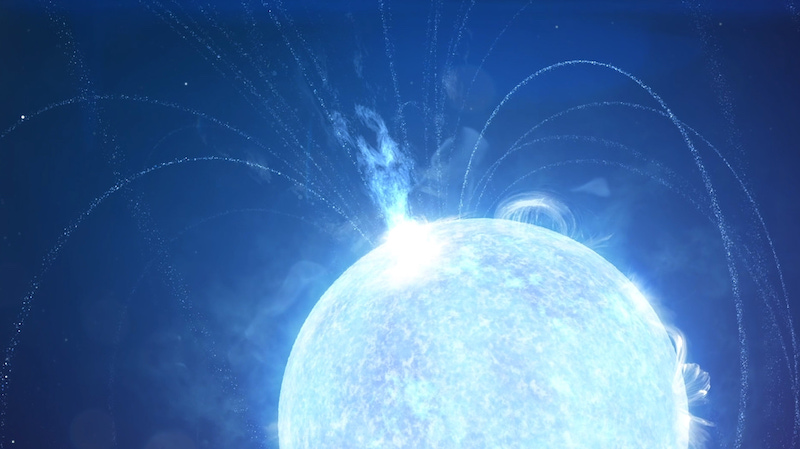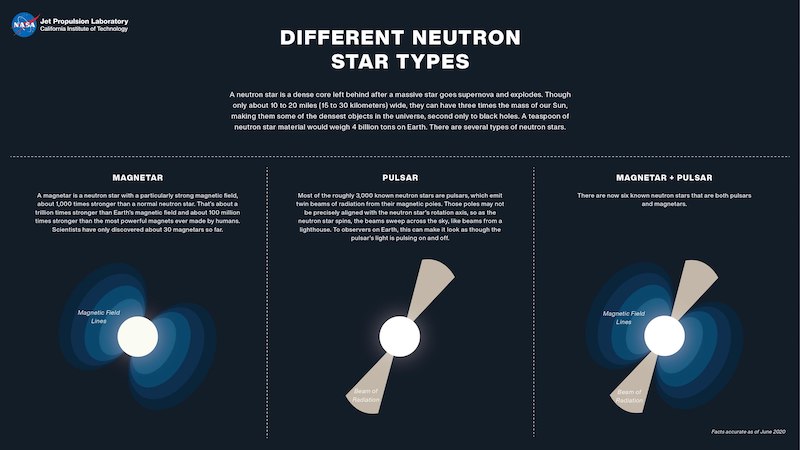
Magnetars are a type of neutron star. That is, they started out as ordinary massive stars that exploded as supernovae. And, at the same time, they imploded, crushing the inner part of the star to become a neutron star. A neutron star spins on a timescale of seconds. It has gravity billions of times stronger than Earth’s and – in the case of magnetars – magnetic fields trillions of times stronger than Earth’s. On October 5, 2020, astronomers were surprised to see a magnetar suddenly slow down. It began emitting radio waves a few days later. What caused this? In late January 2023, scientists suggested an answer: a volcano-like eruption on the surface of the magnetar that spewed a “wind” of massive particles into space.
The researchers published their peer-reviewed findings in January 2023 in Nature Astronomy. There’s also a preprint of the paper available on arXiv.
Magnetar slow-downs are rare
Typically, magnetars rotate once every few seconds. And their rotation slows down only very slowly. Slowing down by a single rotation per second can take tens of thousands of years for a magnetar. Yet – in rare cases, as with the sudden slowdown in 2020 of magnetar SGR 1935+2154 – magnetars can apparently slow down very abruptly.
But astronomers say these abrupt slowdowns of magnetars – which they call anti-glitches – are rare. And they haven’t been sure what causes them. Astrophysicist Matthew Baring at Rice University, one of the lead authors of the paper, tested a new theory along with his colleagues. They used X-ray data from the European Space Agency’s X-ray Multi-Mirror Mission (XMM-Newton) and NASA’s Neutron Star Interior Composition Explorer (NICER) to study SGR 1935+2154’s 2020 slowdown.
The results suggest an interesting scenario: a volcano-like eruption or rupture that might have caused the slowdown. It could have done so by spewing a “wind” of massive particles out into space. And this “wind” might have altered the magnetar’s magnetic fields. This, in turn, could have caused the magnetar to slow down suddenly, and to start generating radio waves. Baring said:
People have speculated that neutron stars could have the equivalent of volcanoes on their surface. Our findings suggest that could be the case and that on this occasion, the rupture was most likely at or near the star’s magnetic pole.
Glitches and anti-glitches
Magnetars don’t just slow down. They can also speed up. Scientists call an abrupt increase in rotational speed in a magnetar a glitch. That’s why sudden slowdowns are called anti-glitches. Glitches are usually caused by sudden shifts within the magnetar itself. As Baring explained:
In most glitches, the pulsation period gets shorter, meaning the star spins a bit faster than it had been. The textbook explanation is that over time, the outer, magnetized layers of the star slow down, but the inner, non-magnetized core does not. This leads to a buildup of stress at the boundary between these two regions, and a glitch signals a sudden transfer of rotational energy from the faster spinning core to the slower spinning crust.

2020 magnetar slowdown was unique
Indeed, the sudden slowdown of magnetar SGR 1935+215 in October 2020 was a unique event, the researchers say. As Baring explained:
A strong, massive particle wind emanating from the star for a few hours could establish the conditions for the drop in rotational period. Our calculations showed such a wind would also have the power to change the geometry of the magnetic field outside the neutron star. The general properties of the X-ray pulsation likely require the wind to be launched from a localized region on the surface.
What makes the October 2020 event unique is that there was a fast radio burst from the magnetar just a few days after the anti-glitch, as well as a switch-on of pulsed, ephemeral radio emission shortly thereafter. We’ve seen only a handful of transient pulsed radio magnetars, and this is the first time we’ve seen a radio switch-on of a magnetar almost contemporaneous with an anti-glitch.
Hence, the timing suggests that the same event caused both the slowdown and radio emissions. Baring added:
The wind interpretation provides a path to understanding why the radio emission switches on. It provides new insight we have not had before.
Extreme objects
Magnetars are extreme in many other ways, too, not just because of their strong magnetic fields. For example, they release vast amounts of energy in the form of flares, X-rays and gamma-ray bursts.
They can even affect Earth’s magnetic field. In 2004, a flare on the surface of a magnetar compressed the magnetic field of the Earth from a distance of 50,000 light-years!
A neutron star’s interior becoming a superconducting fluid might create the magnetic field of a magnetar. Astronomers say the interior is made up of neutrons, quarks and exotic states of matter such as Bose-Einstein condensates.
A few magnetars are also known to be both magnetars and pulsars, those “cosmic lighthouses” of the universe.
They are fascinating! And this study may be a stepping stone to understanding them better.
Bottom line: Astronomers say they think they know why a rapidly spinning magnetar slowed down suddenly in 2020. They say a powerful volcano-like eruption on the magnetar’s surface is to blame.
Source: Magnetar spin-down glitch clearing the way for FRB-like bursts and a pulsed radio episode











